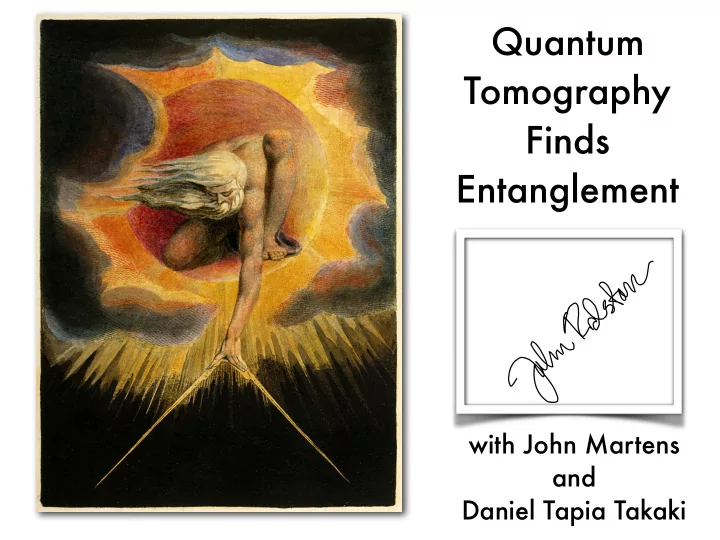

Quantum Tomography Finds Entanglement with John Martens and Daniel Tapia Takaki
Executive Summary We bypass 75 years of field theoretic formalism and particle physics superstructure to describe systems model-independently in terms of basic quantum mechanics Schoolbooks talk about wave functions! Inclusive experiments measure density matrices traced down from larger density matrices But first: An advertisement
An accessible introduction to understanding quantum mechanics in a Made to natural and intuitive way, which was advocated by Erwin Schroedinger and Albert Einstein correct disinformation How to Understand Quantum Mechanics given to students John P. Ralston, Ti e University of Kansas Paperback ISBN: 9781681741628 • eBook ISBN: 9781681742267 and all of us May, 2018 • 107 pages Paperback: $79.95 • eBook: $63.96 • Combo: $99.94 How to Understand Quantum Mechanics presents an accessible introduction to understanding quantum mechanics in a natural and intuitive way, which was advocated by Erwin Schroedinger and Albert No principles! Einstein. A theoretical physicist reveals dozens of easy tricks that avoid long calculations, makes complicated things simple, and bypasses the worthless anguish of famous scientists who died in angst. T e author’s No postulates ! approach is light-hearted, and the book is written to be read without equations, however all relevant equations still appear with explanations Quantum mechanics as to what they mean. T e book entertainingly rejects quantum disinformation, the MKS itself is descriptive , unit system (obsolete), pompous non-explanations, pompous people, the hoax of the ‘uncertainty principle’ (it is just a math relation), and the accumulated junk-DNA that got into the quantum operating system by misreporting it. T e order of presentation is new and also unique by warning not predictive about traps to be avoided, while separating topics such as quantum probability to let the Schroedinger equation be appreciated in the simplest way on its own terms. T is is also the fj rst book on quantum theory that is not based on arbitrary and confusing axioms or foundation principles. T e author is so unprincipled he shows where obsolete principles duplicated basic math facts, became redundant, and sometimes were just pawns in academic turf wars. T e book has many original topics not found elsewhere, and completely researched references to original historical sources and anecdotes concerning the unrecognized scientists who actually did discover things, did not all get Nobel prizes, and yet had interesting productive lives. Institute of Physics ABOUT THE AUTHOR John P Ralston, PhD, is a Professor of Physics and Astronomy at T e University of Kansas. He received his series will be PhD in high-energy theory physics from the University of Oregon. His research interests include high energy theory, strong interaction physics, particle astrophysics, cosmology, and practical data analysis. in your library. CONTENTS • Introduction • T e Continuum Universe You don’t need to buy it • Everything is a Wave • T ere is No Classical T eory of Matter • Matter Waves
Actual Real Simulated Data Begin with Some Results “dijets” means 2 LHC jets, each made of many particles plus everything else not measured histograms show a Lorentz-invariant angular distribution of jet1 v jet 2 measuring a density matrix raw data processed, bypassing 600 pages of theory papers
mandatory diagram for collider theorists
EXAMPLE: Experimentally measure the polarization density matrix of a Z boson = known density matrix = unknown density matrix The notation does not look Lorentz invariant, but the quantities are
Begin with ATLAS data 1606.00689 Some Results “lepton pairs” one of many terms in an old traditional expansion QCD is not working well of a certain angular distribution “Lam-Tung fails” P T of Z = our q T
The density matrix eigenvalues are strange red: Born blue: ATLAS data what is this? what is this? q T P T of Z = our q T there is no precedent for the resonance-like bump
The entanglement entropy is strange this has S never been seen before
Tomography builds higher dimensional structure from lower dimensional projections probe operators observable: reconstruction: Completeness? It’s complete for what it spans
Recommend
More recommend